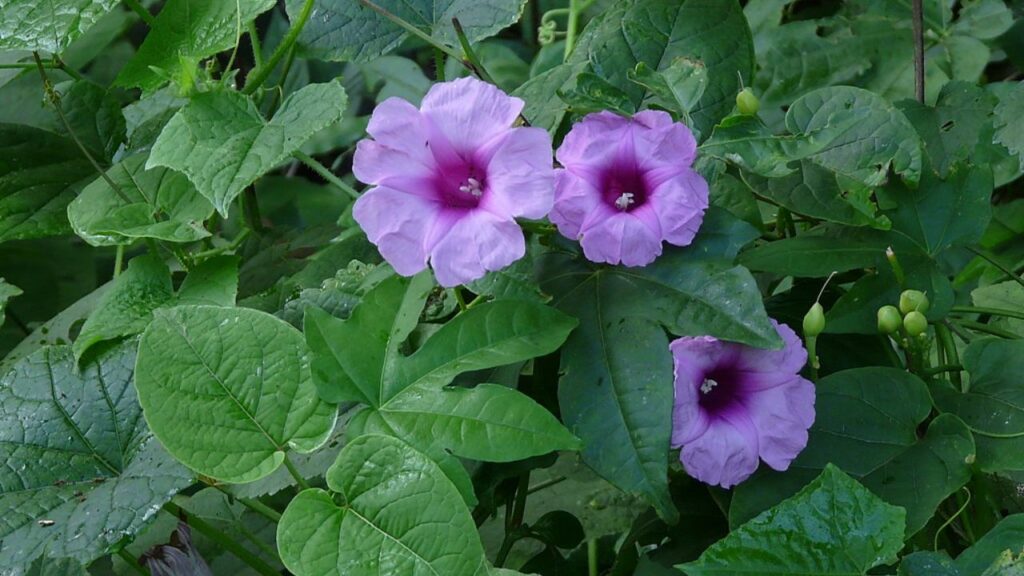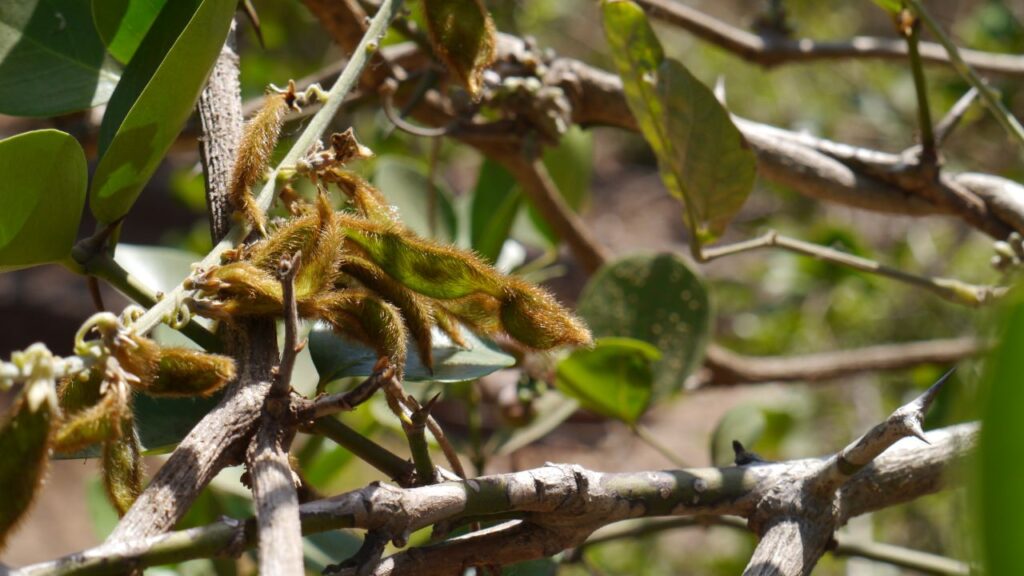
Family: Leguminosae
Biological classification
- Kingdom: Plantae
- Subkingdom: Trachebionta
- Superdivision: Spermatophyta
- Division: Magnoliophyta
- Subclass: Rosidae
- Order: Fabales
- Family: Fabaceae
- Genus: Pueraria DC.
- Species: Pueraria tuberosa
Introduction To Vidari
Pueraria tuberosa, commonly known as kudzu, Indian kudzu, or Nepalese kudzu, Vidarikand, Sanskrit: Bhukushmandi is a climber with woody tuberculated stem. It is a climbing, coiling and trailing vine with large tuberous roots.

Habitat / place of origin
It is native to India, Pakistan, and Nepal.
Synonyms of Vidari
Sanskrit : Vidari , Swadukanda , Ikshu-Gndha , Kandpalash , Bhumikushmand ,
Assamese: Bhedeleton , Bhuikumra
Bengali: Shimiya
English: Indian Kudju
Gujarati: Khakharavel , Vidari
Hindi: Vidarikanda , Balayikand , Sural , Patalkoheda
Kannada: Nelagumbala Gudde , Gumadi Belli
Malyalam :Gumdigida
Marathi: : Bedariya , Beal, Vindari
Oriya: Bhuiankakharu
Tamil : Ghodbeal
Telugu : Darigummadi
Morphology of Vidari
Very large tuberous roots.
Stem: It is a large spreading tuberous, deciduous climber or twining shrub.
Leaves: Leaves are pinnately compound, three foliolate with long petioles. Leaflets are broadly oval or trigonal, sub-coriaceous, glabrescent above and densely hairy with silky hairs.
Flower: It is blue or purplish blue in colour. It is leafless 15-27 cm long racemes. Calyx is 0.4-0.6 cm long densely silky. Corolla is bluish, larger and papilionaceous.
Fruit : Fruits are membranous.
- Jointed and flare 5-7.5 cm long pods
- It contains 2- 3 seeds coated with long,silky , bristly brown hairs
Flowering time: Flowers appear in april
Medicinal Parts of Vidari
Tuber

Plant variety of Vidari
Ksheer-vidari:
-
- Botanical name :Ipomoea digitata
- Family : Convolvulaceae
- Also known as : bhuyikuheda , pyasawani , sheervalli
- It has climbing stem
- Leaves are five in no. or sometimes seven
- Bell shaped flowers which are pink , purple coloured
- Flowering season : raining season
- Tuber is yellow or browned coloured and white on cutting
Another plant in Bengal and assam found in name of bhuyikuheda
-
- Botanical name : Trichosanthes cordata
- Family : Cucurbitaceae
Chemical composition of Vidari
- Carbohydrate =64.6%
- Protein =10.9%
- Pterocarpan Tuberosum, pterocarpanone –hydroxy
- Tuberosone
- Two Pterocarpan -anhydrotuberosin
- 3-o-methyl anhydrotuberosin
- A coumestan tuberostan
- Isoflavone–puerarone
- Coumestan
- Puerarostan6
- Phytoestrogen puerarin
- Β- sitosterol
- Stigmasterol
- Duidzein
- Tuberosin
- Puerarin
Ayurvedic Properties of Vidari
Rasa (Taste) : Madhur
Guna (Quality) : Guru , Snigdha
Virya (Potency) : Shitta
Vipak (Post Digestive Effect): Madhur
Karma (Pharmacological Actions) of Vidari
Dosha Karma : It Vata-Pitta Shamak
Pachan Sansthan (Digestive System ): Snehan , Pittasarak , Anuloman
Raktvahsansthan (Cvs): Hridya , Shonitsathapan
Swasansasthan (Respiratory System ): Kaphanisarak , Kanthaya
Prajanana Sansthan (Reproductive System ): Vrishya , Satanayjanan
Mutravahsansthan (Urinary System ): Mutarl
Tavcha (Skin): Varnaya
Tapkarma (Thermoregulations ): Jawarghan .Daha Parsaman
Balaya , Brihan , Rasayan
Qualities/Effects on Tridosha of Vidari
It reduces vata dosha by snigdha-madhur guna , and pitta by shitta virya
Formulations of Vidari
- Saraswatarishta
- Marma gutika
- Vidaryadi Kwatha churna
- Vidaryadi ghrita
- Manmathabhra rasa
- Aparah
Therapeutic Uses of Vidari
- It is indicated in all vata and pitta diseases
- It is indicated in liver and spleen enlargement
- Indicated in blood disorders
- In is indicated for breast milk enhancement
- It indicated for strengthen the body
- It is indicated in fever and chronic fever
- Indicated in skin disorders
- Indicated in sore throat
- Indicated in cough
- Aphrodisiac, cardio-tonic,
- Galactagogue
- The tubers used for the dysuria treatment ,
- Emancipation
- Spermatorrhea
- In malarial fever
Dosage of Vidari
Powder= 3-6gm
How can you consume Vidari?
It is administered in the form of Kalka (paste), Shrita / kwath (decoction), Swaras (juice), Shita (cold infusion), Phant (hot infusion), Churna (powder), Ghrita (ghee) or Arka (tincture), and it is used as a main component in different formulations.

Benefits of Vidari
- Useful in managing Coronary heart disease
- It formation of blood clots which improves the flow of blood to the heart.
- Vidarikand might help manage Diabetes
- Using vidari can reduces the the blood sugar levels.
- It also prevents damage to pancreatic cells, And which leads to increase insulin secretion and sensitivity
- Protect the kidney against damage
- It helps in management of diabetic nephropathy
- It also improves oxygen exchange in the kidney cells.
- Vidarikand promotes physical strength, muscular strength, and body weight
- Vidarikand might help manage high blood pressure
- It may useful in low back pain.
- Improve dryness in the vaginal area
- It may also lowers the risk of a Heart attack
- Against strokes.
- It reduces the symptoms of flu and fights during seasonal changes
- Vidarikand is used to manage Muscle pain or fatigue .
- It is used in gastritis
- It helps in reduce stomach pain
- It also inhibits the gastric acid production in the stomach and gives relief from acidity.
- It also reduces body fat Ultimately reduces body mass index (BMI)
- The powder of vidari root-tubers are in clinical use as anti-aging and also as tonic, aphrodisiac, demulcent, galactagogue , purgative, cholagogue and
- Also used in scorpion sting
- It has been used in for skin care,
- It is also useful in impairment of children, debility and poor digestion
- Possess anti-hypoglycemic activity
- Fever and bronchitis
- Used for glowing skin to improve complexion
Side Effects of Vidari
- Headache
- Fever
- Dizziness
- Skin Itchiness
- It slows blood clotting and due to which it can worsen blood clotting disorders and may interfere with medicine used in the treatment of bleeding or blood clotting disorders
Safety Precautions of Vidari
- It may interfere with blood sugar levels during before and after surgery. It is advised to take Vidarikand before 14 days of surgery
- It might cause allergic reactions
- It is advisable to avoid or consult your doctor before taking Vidarikand during breastfeeding because it have not enough evidence.
- It may react with birth control pills.
- May lower blood sugar levels.
- It is generally advisable to consult your doctor while taking with cardiovascular drugs
- May cause liver damage or worsen conditions of hepatitis Consultation of a doctor is needed before using Vidarikand in patients with liver diseases
- Avoid or consult your before taking Vidarikand during pregnancy because enough scientific evidence is not available
Substitutes & Adulterants of Vidari
Substitute: sheer-vidari
References & Further Reading
- https://www.1mg.com/ayurveda/vidarikand-187
- http://oaji.net/articles/2019/1791-1557150974.pdf
- https://www.ijsdr.org/papers/IJSDR1907023.pdf
- http://echarak.in/echarak/templates/Pueraria%20tuberosa%20(Roxb.%20ex%20Willd)%20DC..pdf
- http://nopr.niscair.res.in/bitstream/123456789/6069/1/IJTK%208(3)%20310-318.pdf
- Api (AYURVEDIC PHARMACOPOEIA OF INDIA) PART-1 VOLUME – II
- DRAVYAGUNA VIGYAN =PV SHARMA




